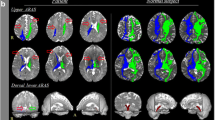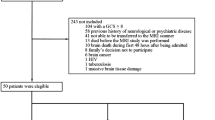Abstract
Introduction
Many studies have reported on vulnerable areas and neural tracts of the brain after hypoxic–ischemic brain injury (HI-BI). However, little is known about injury of the ascending reticular activating system (ARAS). We attempted to investigate on injury of the lower portion of the ARAS in patients with HI-BI using diffusion tensor tractography (DTT).
Methods
Fourteen consecutive patients with HI-BI and 10 control subjects were recruited for this study. We classified the patients into two subgroups according to the preservation of arousal: subgroup A (eight patients)—intact arousal and subgroup B (six patients)—impaired arousal. The lower portion of the ARAS between the pontine reticular formation and the thalamus was reconstructed using the probabilistic tractography method. Fractional anisotropy (FA), mean diffusivity (MD), and tract volume (TV) were measured.
Results
The FA value and TV were decreased in subgroup B compared with those of the control group, although no difference was observed in the MD value (p < 0.05). However, for all DTT parameters, no difference was observed between subgroup A and the control group and between subgroup A and subgroup B (p > 0.05).
Conclusion
Injury of the lower portion of the ARAS was found between the pontine reticular formation and the thalamus in patients with impaired arousal after HI-BI. We believe that analysis using DTT could be helpful in the evaluation of patients with impaired arousal after HI-BI.


Similar content being viewed by others
References
Lu-Emerson C, Khot S (2010) Neurological sequelae of hypoxic-ischemic brain injury. NeuroRehabilitation 26:35–45
Howard RS, Holmes PA, Siddiqui A et al (2012) Hypoxic-ischaemic brain injury: imaging and neurophysiology abnormalities related to outcome. QJM 105:551–561
Anderson CA, Arciniegas DB (2010) Cognitive sequelae of hypoxic-ischemic brain injury: a review. NeuroRehabilitation 26:47–63
Khot S, Tirschwell DL (2006) Long-term neurological complications after hypoxic-ischemic encephalopathy. Semin Neurol 26:422–431
Dougherty JH Jr, Rawlinson DG, Levy DE et al (1981) Hypoxic-ischemic brain injury and the vegetative state: clinical and neuropathologic correlation. Neurology 31:991–997
Hoesch RE, Koenig MA, Geocadin RG (2008) Coma after global ischemic brain injury: pathophysiology and emerging therapies. Crit Care Clin 24:44–25, vii-viii
Mills VM, Cassidy JW, Katz DI (1997) Neurologic rehabilitation: a guide to diagnosis, prognosis, and treatment planning. Blackwell Science, Malden, MA
Chalela JA, Wolf RL, Maldjian JA et al (2001) MRI identification of early white matter injury in anoxic-ischemic encephalopathy. Neurology 56:481–485
Cummings JL, Tomiyasu U, Read S et al (1984) Amnesia with hippocampal lesions after cardiopulmonary arrest. Neurology 34:679–681
Hawker K, Lang AE (1990) Hypoxic-ischemic damage of the basal ganglia. Case reports and a review of the literature. Mov Disord 5:219–224
Hong JH, Jang SH (2010) Diffusion tensor imaging of neural tract injury in a patient with hypoxic-ischemic brain injury. Neural Regen Res 5:1825–1828
Huang BY, Castillo M (2008) Hypoxic-ischemic brain injury: imaging findings from birth to adulthood. Radiographics 28:417–439, quiz 617
Lee AY, Shin DG, Park JS et al (2012) Neural tracts injuries in patients with hypoxic ischemic brain injury: diffusion tensor imaging study. Neurosci Lett 528:16–21
Basser PJ, Pierpaoli C (1996) Microstructural and physiological features of tissues elucidated by quantitative-diffusion-tensor MRI. J Magn Reson B 111:209–219
Mori S, Crain BJ, Chacko VP et al (1999) Three-dimensional tracking of axonal projections in the brain by magnetic resonance imaging. Ann Neurol 45:265–269
Assaf Y, Pasternak O (2008) Diffusion tensor imaging (DTI)-based white matter mapping in brain research: a review. J Mol Neurosci 34:51–61
Puig J, Pedraza S, Blasco G et al (2011) Acute damage to the posterior limb of the internal capsule on diffusion tensor tractography as an early imaging predictor of motor outcome after stroke. AJNR Am J Neuroradiol 32:857–863
Jang SH, Chang CH, Lee J et al (2013) Functional role of the corticoreticular pathway in chronic stroke patients. Stroke 44:1099–1104
Yeo SS, Chang PH, Jang SH (2013) The ascending reticular activating system from pontine reticular formation to the thalamus in the human brain. Front Hum Neurosci 7:416
Edlow BL, Takahashi E, Wu O et al (2012) Neuroanatomic connectivity of the human ascending arousal system critical to consciousness and its disorders. J Neuropathol Exp Neurol 71:531–546
Edlow BL, Haynes RL, Takahashi E et al (2013) Disconnection of the ascending arousal system in traumatic coma. J Neuropathol Exp Neurol 72:505–523
Kremer S, Renard F, Noblet V et al (2010) Diffusion tensor imaging in human global cerebral anoxia: correlation with histology in a case with autopsy. J Neuroradiol 37:301–303
Luyt CE, Galanaud D, Perlbarg V et al (2012) Diffusion tensor imaging to predict long-term outcome after cardiac arrest: a bicentric pilot study. Anesthesiology 117:1311–1321
Neil JJ (2008) Diffusion imaging concepts for clinicians. J Magn Reson Imaging 27:1–7
Scheurer E, Lovblad KO, Kreis R et al (2011) Forensic application of postmortem diffusion-weighted and diffusion tensor MR imaging of the human brain in situ. AJNR Am J Neuroradiol 32:1518–1524
Cavanna AE, Shah S, Eddy CM et al (2011) Consciousness: a neurological perspective. Behav Neurol 24:107–116
Smith SM, Jenkinson M, Woolrich MW et al (2004) Advances in functional and structural MR image analysis and implementation as FSL. Neuroimage 23(Suppl 1):S208–S219
Afifi AK, Bergman RA (2005) Functional neuroanatomy: text and atlas, 2nd edn. Lange Medical Books/McGraw-Hill, New York
Daube JR (1986) Medical neurosciences: an approach to anatomy, pathology, and physiology by systems and levels, 2nd edn. Little, Brown and Co, Boston
Folstein MF, Folstein SE, McHugh PR (1975) Mini-mental state”. A practical method for grading the cognitive state of patients for the clinician. J Psychiatr Res 12:189–198
Teasdale G, Jennett B (1974) Assessment of coma and impaired consciousness. A practical scale. Lancet 2:81–84
Giacino JT, Ashwal S, Childs N et al (2002) The minimally conscious state: definition and diagnostic criteria. Neurology 58:349–353
Seo JP, Jang SH (2013) Different characteristics of the corticospinal tract according to the cerebral origin: DTI study. AJNR Am J Neuroradiol 34:1359–1363
Cervos-Navarro J, Diemer NH (1991) Selective vulnerability in brain hypoxia. Crit Rev Neurobiol 6:149–182
Howard R, Trend P, Russell RW (1987) Clinical features of ischemia in cerebral arterial border zones after periods of reduced cerebral blood flow. Arch Neurol 44:934–940
Newcombe VF, Williams GB, Scoffings D et al (2010) Aetiological differences in neuroanatomy of the vegetative state: insights from diffusion tensor imaging and functional implications. J Neurol Neurosurg Psychiatry 81:552–561
Lee SK, Kim DI, Kim J et al (2005) Diffusion-tensor MR imaging and fiber tractography: a new method of describing aberrant fiber connections in developmental CNS anomalies. Radiographics 25:53–65, discussion 66–58
Yamada K, Sakai K, Akazawa K et al (2009) MR tractography: a review of its clinical applications. Magn Reson Med Sci 8:165–174
Georgiopoulos M, Katsakiori P, Kefalopoulou Z et al (2010) Vegetative state and minimally conscious state: a review of the therapeutic interventions. Stereotact Funct Neurosurg 88:199–207
Ethical standards and patient consent
We declare that all human and animal studies have been approved by the Institutional Review Board at Yeungnam University Medical Center and have therefore been performed in accordance with the ethical standards laid down in the 1964 Declaration of Helsinki and its later amendments. We declare that all patients gave informed consent prior to inclusion in this study.
Acknowledgments
This research was supported by the Basic Science Research Program through the National Research Foundation of Korea (NRF) funded by the Ministry of Education, Science and Technology (2012R1A1A4A01001873).
Conflict of interest
We declare that we have no conflict of interest.
Author information
Authors and Affiliations
Corresponding author
Rights and permissions
About this article
Cite this article
Jang, S.H., Kim, S.H., Lim, H.W. et al. Injury of the lower ascending reticular activating system in patients with hypoxic–ischemic brain injury: diffusion tensor imaging study. Neuroradiology 56, 965–970 (2014). https://doi.org/10.1007/s00234-014-1419-y
Received:
Accepted:
Published:
Issue Date:
DOI: https://doi.org/10.1007/s00234-014-1419-y




